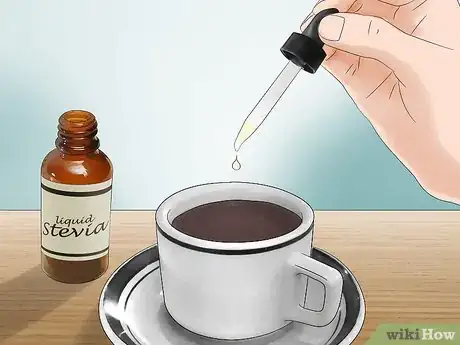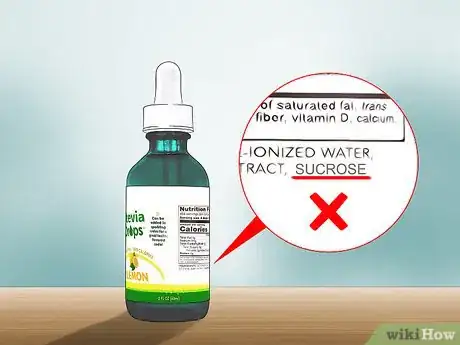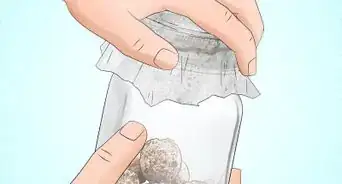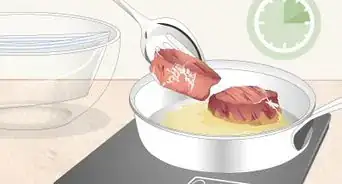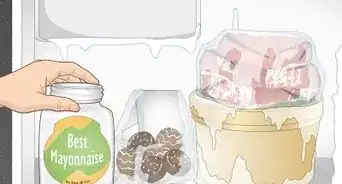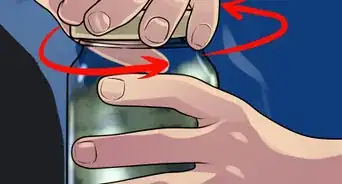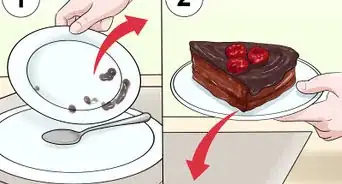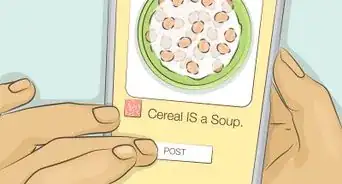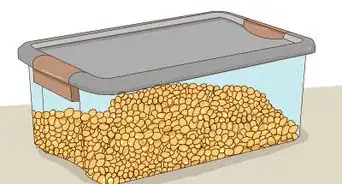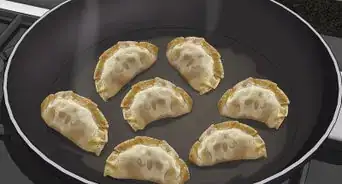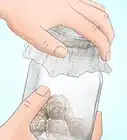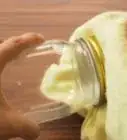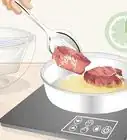This article was co-authored by Maggie Moran. Maggie Moran is a Professional Gardener in Pennsylvania.
This article has been viewed 74,717 times.
Stevia is a calorie-free sugar substitute that is created from the stevia plant. Stevia is popular among health foodies, dieters, and diabetics because it does not increase blood glucose levels. You might use stevia leaf in its refined liquid or powder form, or sweeten your food with fresh stevia leaf. Although high-quality refined stevia is "generally recognized as safe" by the FDA, pure stevia leaf does not have FDA approval for use in food.
Steps
Using Stevia in Liquid or Powder Form
-
1Use pure stevia drops. Perhaps the most popular way to use stevia is in its liquid form. A few drops of stevia can be used to replace 1-2 teaspoons of white sugar. Use stevia drops in drinks (hot or cold), sauces, salad dressings, or soups.[1]
- Stevia can have a bit of a bitter and/or licorice-y aftertaste. Experiment with the number of drops you need to gain optimal sweetness with minimal aftertaste.
-
2Add flavored stevia to beverages. Stevia drops are also available in flavored varieties, such as lemon-lime or root beer. Add a few drops of flavored stevia to sparkling water for a low-calorie alternative to soda.[2]
- Read the labels of flavored stevia options.
- Avoid flavored stevia that contains aspartame or other chemical sugar replacements.
Advertisement -
3Try pure stevia extract powder. Another popular way to use stevia is in its pure powder form. This refined stevia looks similar to sugar, and can be used anywhere you would normally use powdered sweetener. Stevia extract powder is more potent than sugar, however. Use half (or less than half) of the amount of stevia as you normally would for sugar.[3]
- Stevia extract powder can be used in drinks (hot or cold), on cereal, or in recipes.
- It can be purchased in large containers, or in individual packets you can take along with you.
- Look for pure stevia powder. Read all labels and avoid stevia powder with additives.
-
4Bake with stevia. Stevia extract powder can be used to replace sugar in baking. When you bake with stevia, you'll want to use 1/2 the amount of sugar you would normally use (or even less). This means you will need to add more bulk (such as flour) and liquid (such as milk, applesauce, or butter) to account for this difference.[4]
- When you are just starting out, it is best to seek out stevia-based baking recipes.
- Although stevia can replicate the sweetness of sugar, it will not caramelize. of liquid stevia or 1/3-1/2 teaspoon (about .5-.7g) of stevia extract powder.”|SHORT}}
-
5Read all labels and avoid additives. Many packaged stevia products contain additional additives--such as sucrose or aspartame--to mask this. These additives are often artificial, and (unlike pure stevia) can have a negative effect on your blood sugar.[5]
- Be sure to read all labels on your stevia products, and seek out products that contain pure refined stevia.
-
6Mask the aftertaste. Stevia can have a licorice-y aftertaste, which some find bitter. Rather than using stevia that contains artificial additives (intended to mask the taste), you can add a small squirt of agave nectar (which has a low glycemic index), lemon juice, or lime juice to help mask this bitterness.
Using Fresh Stevia Leaf
-
1Use stevia leaves to sweeten tea. If you have access to a fresh stevia plant (or if you have grown your own), you can use fresh stevia leaves as a sweetener. This helps you to eliminate the presence of additives and save money. To sweeten a cup of hot tea, simply remove 1-4 small leaves from your plant and place them in hot water with your tea bag. Remove the leaves after several minutes.[6]
- Although it has been used around the world for thousands of years, unrefined stevia leaf has not been approved as a food additive by the FDA. Before using stevia leaf in your food or drink, it is best to consult your doctor.
-
2Create dry leaf powder. You have two options for drying your stevia leaves. You can either pluck 8 or more leaves from your plant and place them between 2 paper towels, or simply remove an entire stevia stalk and hang it upside down. In either case, leave your stevia leaves in a cool, dry place for a few days. Then grind the dry leaves using a mortar and pestle.[7]
- Use this green powder to sweeten drinks, breakfast cereal, or curries.
- 1 teaspoon of this stevia powder is equal to approximately 10 teaspoons of sugar.
- This pure form of stevia will have a licorice-y or slightly bitter aftertaste.
-
3Make stevia syrup. Once you have stevia dry leaf powder, you can use this to make a stevia syrup. Boil 2 cups of distilled water and add 1 teaspoon of dry leaf powder. Reduce the heat to low and simmer for 10-15 minutes, or until the water is the consistency of syrup. Use a cheesecloth to strain out the powder.[8]
- Store your stevia syrup in an air-tight container in the refrigerator.
- Use this syrup in cold drinks, fruit salads, or sauces.
- Remember that this sweetener will be more potent.
Expert Q&A
Did you know you can get expert answers for this article?
Unlock expert answers by supporting wikiHow
-
QuestionWhat are the side effects of consuming stevia?
 Claudia Carberry, RD, MSClaudia Carberry is a Registered Dietitian specializing in kidney transplants and counseling patients for weight loss at the University of Arkansas for Medical Sciences. She is a member of the Arkansas Academy of Nutrition and Dietetics. Claudia received her MS in Nutrition from the University of Tennessee Knoxville in 2010.
Claudia Carberry, RD, MSClaudia Carberry is a Registered Dietitian specializing in kidney transplants and counseling patients for weight loss at the University of Arkansas for Medical Sciences. She is a member of the Arkansas Academy of Nutrition and Dietetics. Claudia received her MS in Nutrition from the University of Tennessee Knoxville in 2010.
Master's Degree, Nutrition, University of Tennessee Knoxville Master's Degree, Nutrition, University of Tennessee KnoxvilleExpert Answer
Master's Degree, Nutrition, University of Tennessee KnoxvilleExpert Answer -
QuestionHow much stevia is equal to 1 cup of sugar?
 Maggie MoranMaggie Moran is a Professional Gardener in Pennsylvania.
Maggie MoranMaggie Moran is a Professional Gardener in Pennsylvania.
Home & Garden Specialist
-
QuestionWhat are the side effects of stevia?
 Maggie MoranMaggie Moran is a Professional Gardener in Pennsylvania.
Maggie MoranMaggie Moran is a Professional Gardener in Pennsylvania.
Home & Garden Specialist
Warnings
- Critics of the plant are concerned about how it may affect the kidneys, cardiovascular, and reproductive systems.⧼thumbs_response⧽
- Refined stevia has been categorized as GRAS (means generally recognized as safe) by the US Food and Drug Administration. However, stevia leaf and crude stevia extractions have not been approved.⧼thumbs_response⧽
- As with any lifestyle change, it is best to consult your doctor.⧼thumbs_response⧽
References
- ↑ https://wholenewmom.com/kitchen-tips/stevia-what-it-is-and-how-to-use-it/
- ↑ https://wholenewmom.com/kitchen-tips/stevia-what-it-is-and-how-to-use-it/
- ↑ https://wholenewmom.com/kitchen-tips/stevia-what-it-is-and-how-to-use-it/
- ↑ http://news.nationalgeographic.com/news/2013/07/130717-sugar-substitutes-nutrasweet-splenda-stevia-baking/
- ↑ https://wholenewmom.com/kitchen-tips/stevia-what-it-is-and-how-to-use-it/
- ↑ http://commonsensehome.com/stevia-grow-your-own-sweetener/
- ↑ https://www.bbcgoodfood.com/howto/guide/sugar-substitutes-stevia-explained
- ↑ http://commonsensehome.com/stevia-grow-your-own-sweetener/
- ↑ http://www.mayoclinic.org/healthy-lifestyle/nutrition-and-healthy-eating/expert-answers/stevia/faq-20057856
About This Article
To use stevia, use a few drops of it as a substitute for 1-2 teaspoons of white sugar. You can add the drops to drinks, sauces, salad dressings, and soups. If you have stevia powder, use half as much as you normally would for sugar. For example, if you're baking something and it calls for 1 cup of sugar, use 1/2 cup of stevia instead. For more advice from our Horticulture co-author, like how to use fresh stevia leaf, scroll down!
